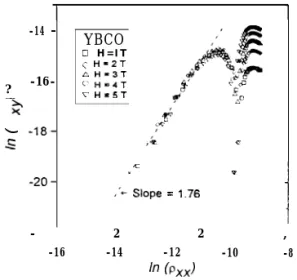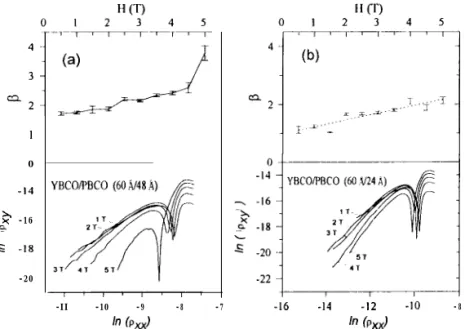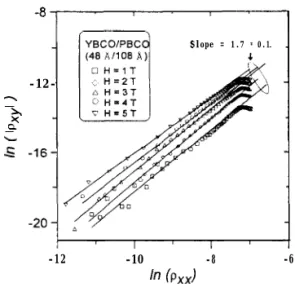CHINESE JOURNAL OF PHYSICS VOL. 36, NO. 3 JUNE 1998
Longitudinal and Transverse Hall Resistivities in High-T, Superconducting Films and Superlattices
H. C. Yang’, H. E. Horng’, and L. M. Wang2
’ Department of Physics, National Taiwan Unaversity, Taipei, Taiwan, R.O.C. 2 Department of Physics, National Taiwan Normal University, Taipei, Taiwan, R.O.C.
(Received February 20, 1998)
The longitudinal and transverse, resistivities pzz and pzy, of high-T, YBazCusO, films and (YBa~CusO,/Y,Prr_,Ba2CuaO~)~ superlattices in a mixed state have been measured systematically to investigate the effects of magnetic field and flux pinning on the behaviors of pzy and prz, the subscript n refers to the number of modulation layer in superlattices. Sign reversal of Hall coefficients is observed and depends on the pinning force. The power law, pzy = Apt,, persists in (YBazCuaOy/Y,Pri_,Ba&uaO,), superlattices with and without sign reversal.
PACS. 74.60.Ge ~ Flux pinning, flux creep, and flux-line lattice dynamics. I. Introduction
_ The observation of the scaling behavior [l], pzyw pg,, of longitudinal and transverse resistivities, pzz and pzy, in a mixed state of high-T, superconductors has attracted much attention, and many effort [2-61, both theoretical and experimental studies, has been put forward to explore the scaling behaviors. Theoretically, Dorsey and Fisher [3] have demon-strated that the scaling behavior is a consequence of the vortex behavior near the vortex glass transition. Vinokur [2] et al. considered the effects of pinning on Hall resistivities and showed that the scaling behavior of Hall resistivities is a consequence of flux pinning. Taking into account of pinning force and thermal fluctuations of vortex, Wang and Ding [4] are able to demonstrate that the anomalous Hall elfect and the scaling behavior of Hall resistivities. In this work, the longitudinal and transverse resistivities of high-T, multilayers in a mixed state have been measured systematically to investigate the effects of magnetic field and flux pinning on the behavior of pzcy and pzz. The samples investigated were YBazCusO, films, ((YBa2CusO,/Y,Pri_,BazCu30,), (YBCO/PBCO) for z = 1 and (YBCO/YPBCO) for z = 0.5) superlattices, the subscript n refers to the number of modulation layer in super-lattices. The superlattices were investigated because we can alter the pinning ability of the samples by varying the thickness of each individual layer.
II. Experimental
The YBCO films, YBCO/PBCO, and YBCO/YPBCO superlattices were prepared in situ using an a off-axis rf magnetron sputtering system. The detailed description of
5 2 7 @ 1998 THE PHYSICAL SOCIETY OF THE REPUBLIC OF CHINA
528 LONGITUDINAL AND TRANSVERSE HALL RESISTIVITIES VOL. 36
the YBCO/YPBCO superlattices was described in literature [5]. The sputtering gas was a mixture of Ar and 02 (3:7). The samples were prepared at T = 720 N 750 “C. For longitudinal and transverse Hall resistivities measurements, the sample was patterned to a conventional five-lead Hall pattern. Au pads were evaporated onto the Hall and resistivity leads. The current density in the Hall measurements varied from 1 x lo3 to 1 x lo4 A/cm2.
III. Results and discussion
III-l. Behaviors of ply and pzz in YBCO films
In Fig. 1 we show typically InIp,,/ versus lnp,, in log-log plot for YBCO films under magnetic fields parallel to the c-axis, the data were taken at H = 1, 2, 3, 4 and 5 T. The cusp is an artifact of the absolute value lpzyl corresponding to a value where lpzcyj passed through zero. The data clearly display a scaling-law relationship in the regime of negative Hall coefficient. In this regime, the data of I lnp,,) and lnp,, merge into the dashed line for all fields. The dashed line indicates the scaling law, pzy N p&, with p = 1.76 and is independent of magnetic field, which is consistent with the observation of Luo et al [l].
111-2. Behaviors of pzy and pzz in YBCO/PBCO superlattices
In Fig. 2 we plot the detailed measurements of lnlp,,l versus lnp,, in log-log plot for YBCO/PBCO (60 A/48 8’)rs and (60 A/24 A) 1s superlattices under various magnetic fields. The increment of the magnetic field in each curve is 1 T. T,,,,,, equals to w 81 and 85 K respectively for YBCO/PBCO (60 A/48 A)rs and (60 A/24 A)rs superlattices. The -samples reveal satellite peaks in the powder x-ray diffraction pattern confirm the superlattice structure. The superlattices reveal sign reversal in mixed state Hall coefficients. The upper panels show the exponent /? (in pzy N pg,) as a function of magnetic fields. It
14 -YBCO -16-? 3 - -18-I 0 H = l T c H=2T c H-3T (‘H=4T i H=ST c 1 s -2o-,‘- Slope = 1.76 i - 2 2 , -16 -14 -12 -10 -8 In bXX)
FIG. 1. lnlp,, 1 versus lnp,, for YBCO films under magnetic fields parallel to the c-axis, the data were taken at H = 1, 2, 3, 4 and 5 T .
VOL.36 H.C.YANG,H.E.HORNG,AND L.M. WANG 529 0 -14 ? -16 FL s -18 -20 -II -10 -9 -8 -7 -16 -14 -I2 -10 -8 In (P& In (P&
FIG. 2. The exponent p of the power law ply N pg, as a magnetic field and InIp,, 1 versus lnp,, under magnetic fields tor (a) YBCO/PBCO (60 A/48 A),, and (b) (60 A/24 d;)is superlattices.
is clear that there exist a power law of pzy = A&,, with A and /? depend on magnetic fields for YBCO/PBCO superlattices. The exponent in pzy N pEz increases with increasing magnetic field as shown in the upper panels of Fig. 2. The /3 value ranging from 1.65 to 3.75 for YBCO/PBCO (60 A/48 A) 1s superlattice and from 1.2 to 2.1 for YBCO/PBCO (60 A/24 A),, can roughly predicted by Vinokur et al. [2] or Dorsey et al. [3] but not the magnetic field dependent.
Additionally, another power law behavior in pzy and pzz for strong anisotropic and weak- pinning superlattice of YBCO/PBC0(48 A/108 A),, is shown in Fig. 3. The Hall resistivity, pzy does not undergo a sign change in the mixed state regime. However, the data clear display a striking scaling relationship in the thermally activated flux flow regime. The solid line in each curve is the fit to the power law pzyw p& with p = 1.7f 0.1 under various magnetic fields. This scaling behavior is similar to that of T12Ba2Ca2Cuj0, films observed by Samoilov [9] that the scaling law is observed in the low field regime where pzy is negative and the pzy~p~, relation holds in higher magnetic fields where pzy is positive. The results that the sign anomaly and scaling law are unrelated is not queer. Dorsey et al. [3] and Vinokur et al. [2] both have suggested that the scaling behavior is independent of the sign of Hall resistivity in their analysis. The present results demonstrate that the anomalous behavior of the sign change in Hall voltage is independent of the scaling relationship between pxy and pxx.
III-3 Behaviors of pzy and pzz i n Y B C O / Y P B C O s u p e r l a t t i c e s
In Fig. 4 we plot typically ln]p,,] versus lnp,, for an YBCO/YPBCO (120 A/60 A), superlattice under magnetic fields 1, 2, 3, 4 and 5 T. The resistivity is 372 ,&-cm at 300
530 LONGITUDINAL AND TRANSVERSE HALL RESISTIVITIES “. VOL. 36 -12-? -A ax L. h -16-Slope = 1.7 f 0.1 -12 -10 -8 -6 IfI (Pxx)
FIG. 3. lnp,, versus Inp,, in log-log plot for a strong anisotropic (48 A/l08 A)20 superlattice.
K
and
T,,zeTo N 80.4 K. This superlattice shows sign reversal in mixed Hall coefficient and the scaling law pzy N pg, holds. The exponent ,R equals to about 1.7 f 0.1 and is nearly independent of magnetic fields. It is not queer that the YBCO/YPBCO show a scaling behavior with ,0 N 1.7 f 0.1 because the resistivity of YPBCO layer is conducting and has Tc,teTO_ at about 10 K. The flux spinning ability of YBCO/YPBCO (120 A/60 A) superlattice is stronger than that of YBCO/PBCO (60 A/48 A) superlattice determined from pzz in the thermally activated flux flow regime.Li et al. [6] have investigated the effects of pinning force on the sign reversal and scaling law in a series of (YBCO),/(PBCO)s superlattices. They found that the Hall anomaly is diminishing or even disappears with decreasing pinning strength energy. The scaling law always holds for all samples but with somewhat different values of /3. Their results suggested that the Hall anomaly is closely related to the pinning force and consistent with the theoretical prediction of Wang and Ding [4].
Wang et al. [lo] h ave systematically investigated the effects of pinning on the sign reversal and the power law behavior pzyw p& for YBCO/PBCO superlattices with varied thickness of YBCO and PBCO layers. A deminishing negative Hall coetficient was observed when the pinning force of YBCO/PBCO superlattices was decreased. The power law, pzy N Pfz> exists for a YBCO/PBCO (120 A/48 A) superlattice with a strong pinning force and p (p varies from N 1.5 f 0.2 to N 1.7 f 0.1) is nearly independent of the magnetic field. A strong magnetic field dependent of ,0 (p varies from N 1.2 f 0.1 to N 4 f 1) was observed tor a YBCO/PBCO (36 A/48 A) superlattice with a weaker pinning force. The YBCO/PBCO (36 A/48 A) superlattice fails to exhibit negative Hall coefficient in magnetic fields of 4 T and 5 T and the power law behavior, pzy N p!,, still persists. These results further demonstrated that the anomalous behavior of the sign change in Hall voltage is independent of the scaling relationship between pzy and pz2: and p can be magnetic field dependent.
The scaling behavior of longitudinal, pzz, and transverse, pzy resistivities in high-T,, YBCO films as reported by Luo et al. [l] has been argued to be a consequence of
vortex-VOL. 36 H. C. YANG, H. E. HORNG, AND L. M. WANG 531
YBCO I PYBCO
(~zoA/ 60A)
FIG. 4. In(p,,l versus Inp,, for a YBCO/YPBCO (120 A/60 A)s superlattice under magnetic fields 1, 2, 3, 4 and 5 T.
glass transition with the presence of disorder. An alternative explanation of the scaling behavior was suggested by Vinokur et al. [2] that the scaling law is a general feature of any-vortex state with disorder-dominated dynamics and is a consequence of flux pinning. The experimental support for their idea come from the observation of scaling pzy N ~2, by Samoilov [9]. Wang, Dong and Ting [4] (WDT) h ave developed a unified theory based on the normal core model of Bardeen and Stefan [la] and taking into account both the backflow effect and thermal fluctuations of the vortex. They demonstrated that the anormalous Hall effect and the scaling behavior of Hall resistivities is a consequence of the pinning and the thermal fluctuation. Although the thermal fluctuation has been taken into account, the pinning force still play an essential role in the WDT theory.
Recently, Hall coefficients of YBCO/PBCO superlattice in the flux-flow regime under varied current density and temperature ranges were reported by Yang et al. [la]. In the low current density regime, it was observed that pzz is ohmic and the Hall resistivity is pzy negative and indenpendent of the current density. In the high current density regime, the pzy reverts from negative to positive and a sign change in pzy occurs in the flux flow regime. Futhermore, the pzz and pzy were found to obey the power law pzy N pi, with /? = 1.7 f 0.05 over wide current density and temperatures. In the present work, the sign revesal of Hall coefficient was observed to depend on the pinning forces. The scaling law holds for samples with strong pinning force and it persists in samples with weak pinning force. The scaling behavior is independent of the sign of transverse Hall resistivity.
IV. Conclusion
The longitudinal and transverse resistivities were measured systematically in YBCO films and YBCO/YPBCO multilayers in mixed state. Sign revesal of Hall coefficient was observed depending on the pinning forces. The scaling law holds for samples with strong
532 LONGITUDINAL AND TRANSVERSE HALL RESISTIVITIES . VOL. 36
pinning force and it persists in samples with weak pinning force. The scaling behavior is independent of the sign of transverse Hall resistivity. The anomalous behavior of the sign change in Hall voltage is independent of the scaling relationship between pey and pzz in Y B C O / P B C O s u p e r l a t t i c e s .
A c k n o w l e d g m e n t
The authors thank the National Science Council of R.O.C. for financial support under grants: NSC87-2112-M002-31, NSC86-2112-M002-033 and NSC 86-2112-M002-012.
R e f e r e n c e s
[ 1 ] J. Luo, T. P. Orlando, J. M. Graybeal, X. D. Wu, and R. Muenchausen, Phys. Rev. Lett.
68, 690 (1992).
[2] V.M.V’ mo k ur, V. B. Geshken, M. V. Feigelman, and G. Blatter, Phys. Rev. Lett. 71, 1242 (1993).
[ 3 ] A. Dorsey, and M. P. A. Fisher, Phys. Rev. Lett. 68, 694 (1992).
[ 4 ] Z. D. Wang, J. Dong, and C. S. Ding, Phys. Rev. Lett. 72, 3875 (1994); Z. D. Wang, and C. S. Ding, Phys. Rev. Lett. 25, 3618 (1991); Z. D. Wang, and C. S. Ding, Phys. Rev. B46, 284 (1992).
[ 5 ] H. C. Yang, L. M. Wang, and H. E. Horng, Physica C281, 325 (1997).
[ 6 ] L. M. Wang, H. W. Yu, H. C. Yang, and H. E. Horng, Physica C256, 57 (1996). [ 7 j_ R. C. Budhani. S. H. Luo, and Z. X. Cai, Phys. Rev. Lett. 71, 621 (1993). [ 8 ] K. Li, Y. Zhang, and H. Adrian, Phys. Rev. B53, 8608 (1996).
[ 9 ] A. V. Salmoilov et al., Phys. Rev. Lett. 71, 617 (1993).
[lo] L. M. Wang, H. C. Yang, and H. E. Horng, Phys. Rev. Lett. 78, 527 (1997). [ll] H. C. Yang, L. M. Wang, and H. E. Horng, Phys. Rev. B56, 99 (1997).
[12] J. Bardeen and M. J. Stefan, Phys. Rev. 140, A1197, (1965); J. Bardeen, and M. J. Stetall, Phys. Rev. Lett. 14, 112 (1965).



